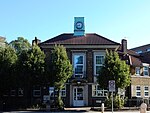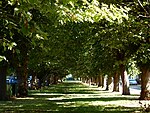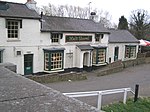River Pinn
Colne catchmentGeography of the London Borough of HillingdonPinnerRivers of LondonUse British English from September 2017

The Pinn is a suburban, outer west London river. It has dendritic headwaters, the furthest is considered its source – in Harrow Weald. Its confluence with Frays River makes it a tributary of the Colne. It is one of three principal rivers wholly in the historic county of Middlesex.
Excerpt from the Wikipedia article River Pinn (License: CC BY-SA 3.0, Authors, Images).River Pinn
Wraysbury Drive, London Yiewsley (London Borough of Hillingdon)
Geographical coordinates (GPS) Address Nearby Places Show on map
Geographical coordinates (GPS)
| Latitude | Longitude |
|---|---|
| N 51.5142 ° | E -0.4797 ° |
Address
Wraysbury Drive
Wraysbury Drive
UB7 7FR London, Yiewsley (London Borough of Hillingdon)
England, United Kingdom
Open on Google Maps









